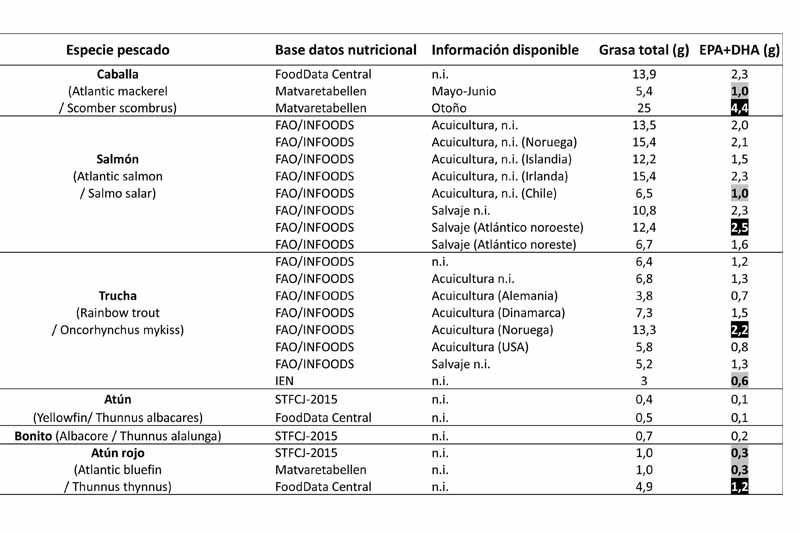Benefits of fish: nutritional value, effects on health and recommended intake
Últimas noticias
An LGTBIQ+ perspective on the animal kingdom
Una mirada LGTBIQ+ al reino animal
Circular Economy in Action: Valorisation of By-products through Projects like PRIMA NEWFEED
MERCEDES CARO, SARA ARRANZ and ITZIAR TUEROS, Food and Health researchers
There are many health benefits of fish, as many scientific studies have shown. Many studies link fish consumption (at least two servings a week) with a reduced risk of cardiovascular disease, depression and all-cause and cancer mortality.
Índice de contenidos
Three reasons to include fish in your (and your family’s) diet
It helps prevent cardiovascular and nervous system diseases: Fish is an important and almost exclusive source, especially in some diets such as the Mediterranean diet, of omega-3 polyunsaturated fatty acids (PUFA), EPA and DHA, which have been associated with the prevention of cardiovascular and nervous system diseases. In fact, a deficit in omega-3 intake in different populations is associated with more than one million deaths per year from cardiovascular diseases globally.
It contributes to the proper growth and development of children, in particular cognitive and visual functions.
It is an excellent source of high quality protein for the diet as it has a very balanced nutritional profile in terms of fat and other nutrients. Fish provides a wide range of essential micronutrients, including vitamins and minerals (such as vitamins D, B6 and B12, niacin, phosphorus and selenium) that contribute to meeting the dietary requirements of the general population and specific groups.
Consumption recommendations to get the maximum benefits from fish
As we said, seafood products provide nutrients of great interest for health, such as omega-3 PUFAs, and for this reason all nutritional guidelines and recommendations establish a minimum number of servings per week that guarantee the recommended intake of these nutrients, unlike other foods that are a source of protein, such as sausages or fatty meats, for which it is recommended to moderate their consumption.
Despite this consensus in recommending a minimum intake, the recommendation varies from country to country, as cultural aspects and commonly consumed fish varieties are taken into account and the recommendation is adjusted to these parameters. These recommended fish portions would provide 250mg/day, the amount of omega-3 PUFA, EPA and DHA, adequate for the general population, as recommended by the European Food Safety Agency, EFSA.
Food safety and nutrition agencies (EFSA, AESAN, WHO) express some limitations on the consumption of particular fish due to the high presence of certain contaminants such as mercury, some toxins and microplastics mainly in larger fish species such as swordfish, bluefin tuna (thunnus thynnus), shark (dogfish and blue shark) and pike, as they can negatively affect the health, mainly of more sensitive groups such as children and pregnant women. For these population groups in particular, the recommendation is not to exceed 3-4 servings/week of fish, prioritising smaller species such as sardines, anchovies and mackerel. However, the majority of epidemiological studies have shown that the benefits of fish intake significantly outweigh the potential risks.
Omega 3 content in seafood products
Seafood is a source of omega-3 PUFA, however, the content of these is highly variable depending on the species of fish, the area of fishing or origin, the feeding of the animal, and the season of the year.This variability in fish itself, in turn, generates variability in the nutritional information declared in the different databases or information sources, which can generate uncertainty about its veracity.
FAO, in an attempt to gather available information, pooled data from various databases and laboratory analyses, published in 2016 a database of the most relevant/consumed fish and shellfish worldwide. This database provides detailed nutritional information and presents average values, as well as minimum and maximum values and the deviation value. This compilation provides an understanding of the variability in the nutritional composition of fishery products and highlights the existing limitations in terms of quality and availability of such information.
The following table shows the nutritional data for different species of oily fish (those with a total fat content of more than 5%) collected from different databases to show this variability.

It can be seen that for some species there is a significant variation in EPA and DHA content. Some fish such as mackerel vary in their omega-3 PUFA composition from 1.0 g EPA+DHA in May-June to 4.4 g in autumn. For salmon, there are also significant differences depending on the origin. We also see large differences in omega-3 content between the different fish species shown, especially between tuna and the rest, even though they are all categorised as oily fish.
Despite all this variability, fish have a high content of PUFA, so that all fish species can carry the nutritional claim “high in omega-3 fatty acids”. Oily fish in particular (with the exception of tuna) have even higher amounts of these fatty acids, and no matter the precise level of omega-3 at the time of consumption, they are a very important source of these fatty acids. Thus, an intake of 2-3 portions of fish per week, with different types of fish alternating, ensures that the minimum recommended intake of 250 mg/day of EPA + DHA (as recommended by EFSA) is reached.







